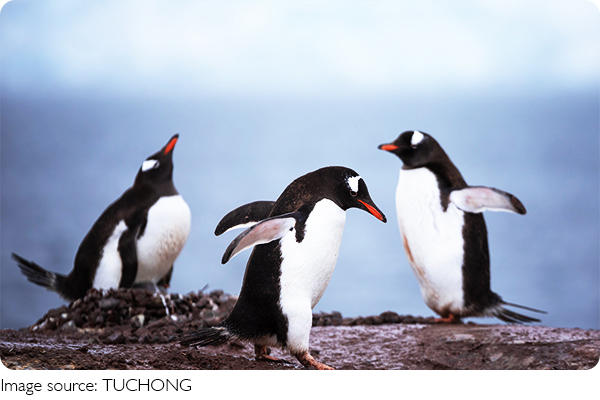Their Wonderful World

Penguins, these adorable black and white creatures, have always been a fascinating subject in nature. They are residents of the Antarctic region. They live in a harsh cold environment, but they have surprising survival skills and interesting behaviors.
In this article, we'll delve into some fascinating facts about penguins, including their species diversity, living habits, unique adaptations, and interactions with humans. Let's explore the wonderful world of penguins together.
1. Species Diversity of Penguins
Many people think that there are only one or two types of penguins, but in fact, there are as many as 18 different penguin species worldwide. These species live in different geographical locations and climate conditions, and each has its unique characteristics and habits.
The swan is a representation of the beauty of nature.
Nature's Rain Predictors and Their Low Flight Behavior
The truth about cat clothing in winter.
Learn more about the heron's appearance, distribution, habits, and lifestyle, as well as its important role in the ecosystem.
The graceful egret lives in a variety of waters and has an array of fascinating characteristics.
The white-headed ibis stork is one of the most endangered birds in the world, with its population declining rapidly.
1. Emperor Penguins: Emperor penguins are the largest penguin species and live in the Antarctic region. They are known for being up to 1.2 meters tall and weighing up to 40 kilograms and are the only penguins that hatch their young during the cold winter months.
2. Emperor Penguin: The Emperor Penguin is the second largest penguin and also lives in the Antarctic region. They can grow up to 1.1 meters tall and are similar to emperor penguins, but have orange spots in their throat area that make them unique.
3. Little Penguin: Little Penguin is the smallest penguin species and lives in Australia, New Zealand, and South Africa. They are usually only 40-45 centimeters tall and are cute miniature penguins.
4. Yellow-browed Penguin: This penguin lives in coastal areas of South America and is famous for its yellow eyebrows. They are the only penguin species that live in tropical climates.

2. Life habits of penguins
Penguins live in extreme environments, so they have developed a unique set of habits to adapt to these conditions.
1. Master swimmers: Penguins are excellent swimmers, and their body shape is very suitable for moving quickly in the water.
They use their wings for paddling and their tails for direction, and can stay underwater for considerable periods to catch food.
2. Living in groups: Penguins are social animals and they often live in large groups to stay warm. This collective approach to warmth helps reduce energy consumption and protects from predators.
3. Precise breeding season: Penguins have a very strict breeding season in the Antarctic region, and their young usually hatch in the cold winter. This schedule ensures that the pups have an adequate food supply during the summer.
4. Nursing their young: Penguins are nursery birds. They hatch their eggs and take care of their young. Female and male penguins usually alternate incubating eggs and feeding their young to ensure their safety and healthy growth.
3. Penguins’ unique adaptability
Penguins live in the frigid Antarctic region and have evolved some amazing survival strategies to adapt to this extreme environment.
1. Excellent thermal insulation mechanism: Penguin feathers are very dense and have a layer of down underneath to maintain body temperature. In addition, their bodies are covered with a special waxy substance that prevents moisture from penetrating and keeps them dry.
2. Energy Saving: Penguins eat almost nothing during the cold winter months to save energy. They use stored fat as energy to support themselves and their hatchlings.
3. Efficient hunters: Penguins hunt for food underwater, and their prey is usually fish and crustaceans. Penguins' excellent swimming skills and sharp beaks make them efficient predators.
4. Cold-proof reproductive habits: Penguins take a series of cold-proof measures when hatching their young, such as placing the eggs tightly inside their bodies, using their bodies to protect the eggs, and forming tight groups of young to minimize body surface exposure. in severe cold weather.
4. Interaction between penguins and humans
Not only are penguins striking in nature, but they also have unique interactions with humans. Here are some interesting examples:
1. Tourist attractions: Many tourist attractions in the Antarctic region attract a large number of tourists, among which penguin viewing is a highlight. Visitors can observe penguins up close, but strict conservation regulations are required to ensure these adorable creatures are not disturbed.
2. Scientific research: Scientists often travel to the Antarctic region to study penguins to understand their behavior, ecosystem role, and adaptation to climate change. Penguin research helps us better protect this fragile environment.
3. Conservation efforts: The living conditions of penguins are facing challenges due to threats such as climate change, pollution, and ecosystem damage. Various organizations and conservation groups are working hard to protect these species and ensure their future.
Penguins are one of the most fascinating creatures on earth. Their species diversity, living habits, and unique adaptations are worthy of in-depth study.
Sharing the adventure of the Antarctic region with penguins not only allows us to better understand the mysteries of nature but also helps us realize the importance of ecological protection.
Penguins are not only amazing, they are an integral part of the planet we live on. We should work to protect them to ensure their beauty and uniqueness continue to exist on our planet.

 · Animal Team
· Animal Team